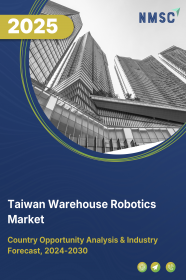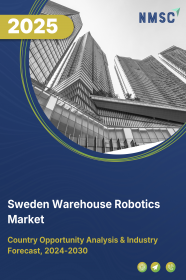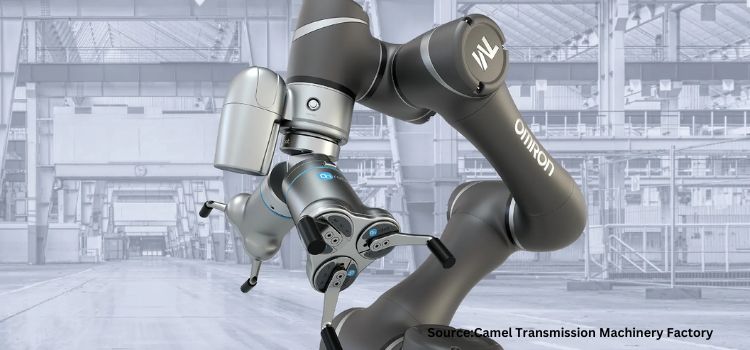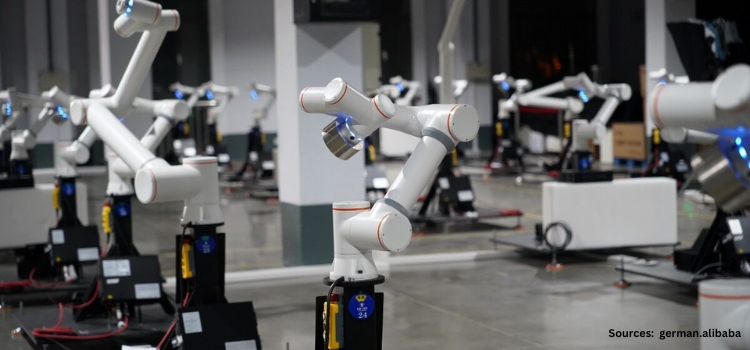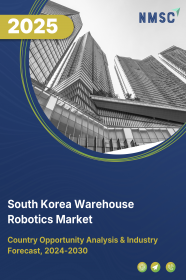
South Korea Warehouse Robotics Market by Type (Automated Guided Vehicles (AGVs), Autonomous Mobile Robots (AMRs), Articulated Robots, & Others), by Offering (Hardware, Software, & Services), by Payload Capacity (Less than 100 KG, 101-200 KG, 201-500 KG, & Others), by Application (Palletizing and Depalletizing, Sorting and Packaging, Picking and Placing, & Transportation) and by End-User (E-commerce, Automotive, Food & Beverages, & Others) – Opportunity Analysis and Industry Forecast, 2025–2030
Industry: Semiconductor & Electronics | Publish Date: 08-Apr-2025 | No of Pages: 224 | No. of Tables: 182 | No. of Figures: 127 | Format: PDF | Report Code : SE3176
US Tariff Impact on South Korea Warehouse Robotics Market
Trump Tariffs Are Reshaping Global Business
South Korea Warehouse Robotics Market Overview
The South Korea Warehouse Robotics Market size was valued at USD 355.7 million in 2024, and is predicted to reach USD 852.3 million by 2030, at a CAGR of 14.7% from 2025 to 2030.In terms of volume, the market size was 18.34 thousand units in 2024 and is projected to reach 47.08 thousand units by 2030, with a CAGR of 15.8% from 2025 to 2030.
South Korea's booming automotive business, driven by important manufacturers such as Hyundai, Kia, and Genesis, is observing a gush in vehicle production and sales, creating a heightened demand for efficient warehousing and logistics operations and also its strong focus on robotic adoptions is an important driver in Warehouse Robotics Market. However, lack of labour workforce is one of the important factors restraining the growth limit the widespread deployment of warehouse robotics, reducing overall market growth in the region.
Increase in Automotive Industry Drives for Warehouse Robotics Industry
Automotive companies boost up their production to meet demands of both domestic and international, managing large volumes of auto parts, components, and finished vehicles requires advanced automation solutions so South Korea's thriving automotive industry, is witnessing a rise in vehicle sales and also in production, creating a massive demand for efficient warehousing and logistics tasks. As per Our World in Data, sales in car in South Korea reached almost 1.67 million units in 2023, with an 8% increase from 1.54 million units in 2022. As South Korea's automotive sector continuing to grow and adopt smart manufacturing techniques, the demand for warehouse robotics is likely to grow massively, reinforcing automation as a vital driver of efficiency and competitiveness in the industry.
Adoption of Robotic Automation Fuels the Market Growth
South Korea is the top leader of robotic automation, driven by its strong focus on robotic adoptions. With industries adapting to robotics to improve productivity and for smooth flowing of operations, the warehouse and logistics industry is observing a rapid transformation. Companies are combining advanced robotic solutions such as autonomous mobile robots, robotic arms, and automated guided vehicles to improve material handling, inventory management, and maintain order fulfilment processes. According to the International Federation of Robotics, Korea has the highest robot density, with 1,012 industrial robots used per 10,000 manufacturing workers more than six times the world average. As there is growth in e-commerce and manufacturing processes the need for warehouse robotics is expected to grow, making automation a vital enabler of efficiency and competition in the logistics industry.
Lack of Skilled Labour Force Hinders South Korea Warehouse Robotics Market Growth
Due to shortage of skilled manpower which is a vital factor restraining the growth of the warehouse robotics market. While robotics can reduce the dependence on manual labour, the fast progress in robotic technologies have created a growing demand for a top specialized workforce that hold the capability of maintaining, repairing, and operating these complex systems. Despite its rich in technology, faces a gap in the availability of skilled workforce with the needed technical expertise to handle the complexities of modern robotic solutions. Consequently, businesses looking to integrate robotics into their operations may face large number of challenges in finding the right talent to manage these systems, ultimately slowing the market's growth.
Introduction of Artificial Intelligence Creates Future Option for the Market
The addition of artificial intelligence in automated warehouses is expected to play a major role allowing growth opportunity for the market in the future. AI induced solutions improves decision making, optimize inventory management and improve the accuracy and speed of operations that helps warehouses to become more accurate and adaptable. As such in January 2025, Nvidia disclosed new AI development tools aimed at improving the potential of autonomous robots and vehicles. These models are mad to create synthetic data and simulate physical interactions, allowing developers to create designed templates for testing their AI systems before real-world. These progresses will focus on the transformative potential of AI in robotic process automation, paving the way for smarter, more lively and highly efficient warehouse operations that meet the future demands of modern supply chains.
Competitive Landscape
The promising players operating in the South Korea warehouse robotics industry includes ABB Ltd., Omron Corporation, KUKA AG, Fanuc Corporation, Teradyne Inc., Geekplus Technology Co., Ltd., Zebra Technologies, Dematic, Honeywell,International Inc, Vanderlande Industries B.V., Daifuku Co., Ltd., YASKAWA ELECTRIC CORPORATION, Toshiba Corporation, SSI Schaefer, GreyOrange, and others.
South Korea Warehouse Robotics Market Key Segments
By Types
-
Automated Guided Vehicles (AGVs)
-
Laser Guidance
-
Magnetic Guidance
-
Optical Tape Guidance
-
Vision Guidance
-
Others
-
-
Autonomous Mobile Robots (AMRs)
-
Tow Vehicle
-
Tug Vehicle
-
Unit Load Vehicle
-
Pallet Truck
-
Forklift Vehicle
-
Other Type
-
-
Articulated Robots
-
Collaborative Robots
-
Scara Robots and Cylindrical Robots
-
Others
By Offering
-
Hardware
-
Software
-
Warehouse Management System (WMS)
-
Warehouse Execution System (WES)
-
Warehouse Control System (WCS)
-
-
Services
By Payload Capacity
-
≤ 100 KG
-
101-200 KG
-
201-500 KG
-
501-1000 KG
-
1001-2000 KG
-
2001-5000K
-
More than 5000 KG
By Application
-
Palletizing and depalletizing
-
Sorting and Packaging
-
Picking and Placing
-
Transportation
By End User
-
E-commerce
-
Automotive
-
Food & Beverages
-
Pharmaceutical
-
Chemical and Materials
-
Semiconductor and Electronics
-
Others
Key Players
-
ABB Ltd.
-
Omron Corporation
-
KUKA AG
-
Fanuc Corporation
-
Teradyne Inc.
-
Geekplus Technology Co., Ltd.
-
Zebra Technologies
-
Dematic
-
Honeywell International Inc
-
Vanderlande Industries B.V.
-
Daifuku Co., Ltd.
-
YASKAWA ELECTRIC CORPORATION
-
Toshiba Corporation
-
SSI Schaefer
-
GreyOrange
REPORT SCOPE AND SEGMENTATION:
|
Parameters |
Details |
|
Market Size Value in 2024 |
USD 355.7 million |
|
Revenue Forecast in 2030 |
USD 852.3 million |
|
Value Growth Rate |
CAGR of 14.7% from 2025 to 2030 |
|
Market Volume in 2024 |
18.34 thousand units |
|
Unit Forecast in 2030 |
47.08 thousand units |
|
Volume Growth Rate |
CAGR of 15.8% from 2025 to 2030 |
|
Analysis Period |
2024–2030 |
|
Base Year Considered |
2024 |
|
Forecast Period |
2025–2030 |
|
Market Size Estimation |
Million (USD) |
|
Market Volume Estimation |
Thousand units |
|
Growth Factors |
|
|
Companies Profiled |
15 |
|
Market Share |
Available for 10 companies |
|
Customization Scope |
Free customization (equivalent up to 80 working hours of analysts) after purchase. Addition or alteration to country, regional, and segment scope. |
|
Pricing and Purchase Options |
Avail customized purchase options to meet your exact research needs. |

















 Speak to Our Analyst
Speak to Our Analyst




